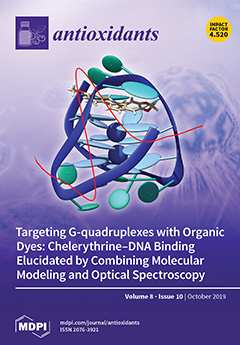High dietary levels of molybdenum (MO) can negatively affect productive performances and health status of laying hens, while tea polyphenol (TP) can mitigate the negative impact of high MO exposure. However, our understanding of the changes induced by TP on MO challenged layers performances and oxidative status, and on the microbiota, remains limited. The aim of the present study was to better understand host (performances and redox balance) and microbiota responses in MO-challenged layers with dietary TP. In this study, 200 Lohmann laying hens (65-week-old) were randomly allocated in a 2 × 2 factorial design to receive a diet with or without MO (0 or 100 mg/kg), and supplemented with either 0 or 600 mg/kg TP. The results indicate that 100 mg/kg MO decreased egg production (
p = 0.03), while dietary TP increased egg production in MO challenged layers (
p < 0.01). Egg yolk color was decreased by high MO (
p < 0.01), while dietary TP had no effect on yolk color (
p > 0.05). Serum alanine transaminase (ALT), aspartate aminotransferase (AST), and malonaldehyde (MDA) concentration were increased by high MO, while total antioxidant capacity (T-AOC), xanthine oxidase (XOD) activity, glutathione s-transferase (GSH-ST), and glutathione concentration in serum were decreased (
p < 0.05). Dietary TP was able to reverse the increasing effect of MO on ALT and AST (
p < 0.05). High MO resulted in higher MO levels in serum, liver, kidney, and egg, but it decreased Cu and Se content in serum, liver, and egg (
p < 0.05). The Fe concentration in liver, kidney, and eggs was significantly lower in MO supplementation groups (
p < 0.05). High MO levels in the diet led to lower
Firmicutes and higher
Proteobacteria abundance, whereas dietary TP alone and/or in high MO treatment increased the
Firmicutes abundance and the
Firmicutes/Bacteroidetes ratio at phylum level. High MO increased the abundance of
Proteobacteria (phylum),
Deltaproteobacteria (class),
Mytococcales (order), and
Nanocystaceae (family), whereas dietary TP promoted the enrichment of
Lactobacillus agilis (species). Dietary TP also enhanced the enrichment of
Bacilli (class),
Lactobacillates (order),
Lactobacillus (family), and
Lactobacillus gasseri (species). Microbiota analysis revealed differentially enriched microbial compositions in the cecum caused by MO and TP, which might be responsible for the protective effect of dietary TP during a MO challenge.
Full article






